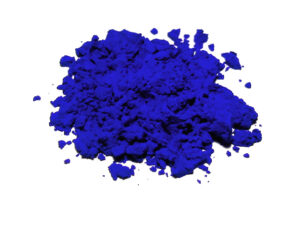A few weeks ago, artist Anish Kapoor posted a photo to Instagram of his middle finger swathed in the “World’s Pinkest Pink” paint pigment with the caption “Up yours #pink”. The photo was a pointed reply to artist Stuart Semple, who had expressly banned Kapoor from acquiring the pink pigment and requiring online purchasers of the color to sign a legal declaration that they were not affiliated with Kapoor in any way.

International Klein Blue
Semple’s efforts to ban Kapoor from accessing his pigments reflect his continued displeasure with Kapoor’s own monopoly of a color: Kapoor is the only artist allowed to use “Vantablack,” a material developed by British company Surrey NanoSystems and purportedly the darkest material in existence. Surrey NanoSystems’s decision to grant exclusive rights to the artistic use of Vantablack to Kapoor was openly condemned by many other artists like Stuart Semple, who wished to use the Vantablack in their own works or believe that colors should be freely accessible to all artists.
The exchanges between Semple and Kapoor reignited a longstanding debate of whether someone can exclusively “own” a color. In most countries a color can be “owned” as a trademark, just like any other logo, design or word. In the US, a color may qualify as a trademark if that color does not serve a functional purpose (such as the colors orange and yellow for safety equipment) and if the color has acquired a “secondary meaning” that identifies that color with a particular brand or source rather than the product itself.
But trademark protection of colors is often limited to very specific commercial purposes and uses. We are all familiar with Tiffany & Co.’s distinctive “Tiffany Blue,” but its trademark rights only apply to boxes, handbags, and catalogue covers. “U.P.S. Brown” applies only to its delivery services, and 3M’s canary yellow color is trademarked only for its popular Post-its.
One of the most famous cases involving the limitations of trademark ownership of a specific color was the dispute between shoe designer Christian Louboutin and Yves Saint Laurent after YSL launched a line of shoes that included a red shoe with a red sole. In 2012, the New York Court of Appeals concluded that Christian Louboutin’s trademarked glossy red-lacquered “outsoles” were only protectable where the red outer sole contrasts with rest of the shoe, and YSL’s shoes, which were entirely red, did not violate Louboutin’s trademark.
So then, how would someone be able to prohibit everyone except one person from using a color like Vantablack? The answer is likely in patent law, which permits a patent owner to exclude anyone from making, using, or selling the patented invention. Unlike trademark law, a patent does not necessarily protect ownership of the color itself. Rather, a patent grants to the owner exclusive ownership rights for the underlying invention, process, or composition that creates the color. It therefore follows that Surrey Nanosystems, as owner of the patents for Vantablack material—not the color itself— would have the right to exclude all artists except Anish Kapoor from using it.
There is a similar common misconception that French artist Yves Klein patented his famed matte blue color known as “International Klein Blue” or “IKB”. In fact, Klein secured a French patent in 1960s for the unique process he developed with art supplier Edouard Adam in Paris to achieve IKB. Although many—from major fashion designers to the Blue Man Group— have attempted replicated IKB, the only places where one can access the “authentic” IKB are Yves Klein’s artworks and the original art supplier in Paris, where the patented process to attain IKB is still used.
Perhaps like the Blue Man Group’s replication of Yves Klein blue, we can look for Semple to create his own “World’s Most Blackest Black” pigment in the future. But in the meantime Stuart Semple has released —and already sold out of—a new pigment called “the World’s Most Glittery Glitter,” which “anyone apart from Anish Kapoor can have,” continuing his mission to #sharetheblack.